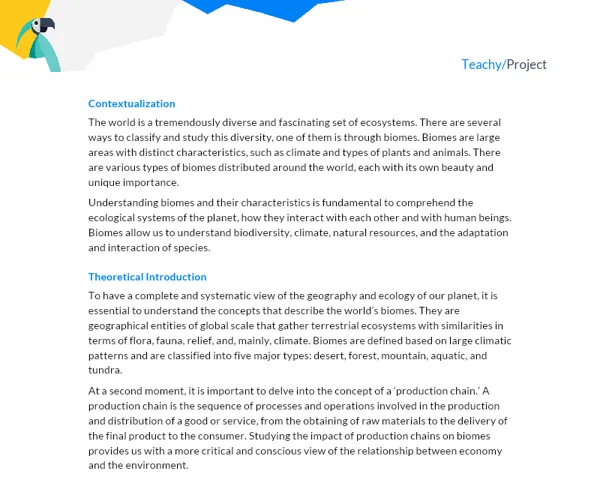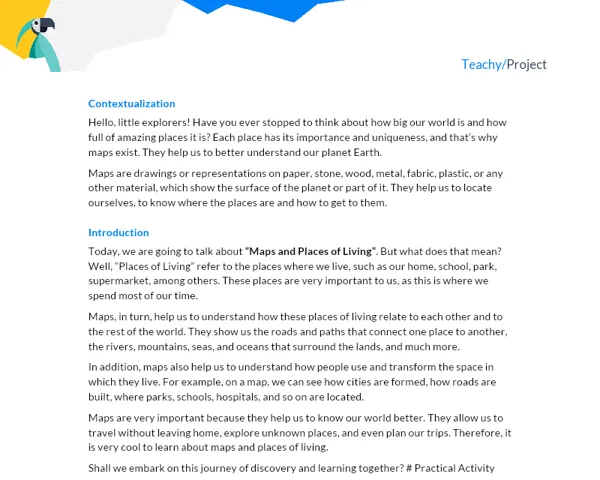Contextualization
Hello, little geographers! Today, we will embark on a fascinating journey through our daily lives together. Have you ever wondered where our houses, clothes, toys, objects, and furniture come from? Well, all of these have an origin and are made of materials that come from different places on our planet.
Earth is a great supplier of natural resources that we use to build our homes, produce clothes, toys, furniture, and other objects we use every day. In this journey, we will explore how these resources are used and how they are related to geography.
Introduction
Geography studies the Earth and everything that happens on it, from immense mountains to the small insects that live in our garden. It helps us understand how people live, how our cities are built, how nature works, and how all these elements are connected.
Within geography, there are different branches of study. One of them is Human Geography, which studies how people live and work, how they organize themselves in society, and how they use natural resources. It is in this branch that we will delve into throughout this project.
The Importance of Natural Resources
Natural resources are elements that nature provides and that humans use to satisfy their needs. They can be divided into three categories: renewable resources, which can be used without being depleted, such as sunlight and air; non-renewable resources, which are depleted with use, such as oil and coal; and inexhaustible resources, which are so abundant that they do not deplete, such as seawater.
We, humans, depend on natural resources to live. We need water to drink, food to eat, wood to build our homes, oil to produce energy, and so on. Therefore, it is very important to understand where these resources come from, how they are used, and how we can use them sustainably, ensuring that they are available for future generations.
Understanding the origin of the materials we use in our daily lives and how they are related to geography is a way to become more conscious of our role on the planet. Are you ready to embark on this adventure together? Get ready to discover many interesting things!
Practical Activity: 'The Journey of Objects'
Project Objective
The objective of this project is for students to understand the relationship between their everyday objects (toys, clothes, furniture, etc.) and the origin of the materials that compose them, developing research, communication, creativity, and time management skills.
Detailed Project Description
Students, divided into groups of 3 to 5 participants, will carry out the practical activity 'The Journey of Objects.' Each group will choose a common object of daily use and, over two weeks, will research the origin of the materials that compose the object, describe the production and transportation process, and the environmental impact of its manufacturing and disposal.
In addition, students should create a world map, identifying the countries of origin of the materials, the countries through which they passed during transportation, and the countries to which they are exported or disposed of.
Necessary Materials
- Notebook for notes
- Internet access for research
- Colored pencils, pens, and ruler
- Cardboard or poster board for the world map
- Scissors and glue
Step by Step
-
Object Selection: Each group must choose a common object of daily use. It can be a toy, a piece of clothing, a piece of furniture, or any other object that is accessible for research.
-
Research: Based on the object chosen, students should research the materials that compose it. Where are these materials found? How are they extracted? How are they transformed into a product?
-
Production Process: Students should describe the production process of the object, from the extraction of materials to the manufacturing of the final product. How is the object produced? What are the stages of the production process? What machines and tools are used?
-
Transportation: Students should investigate how the object is transported. Where does it come from? Which countries does it pass through? What are the means of transportation used? How is the transportation done until it reaches the final destination?
-
Environmental Impact: Students should identify the environmental impact of the manufacturing and disposal of the object. What toxic materials are used in production? How are these materials disposed of? How does the disposal of the object affect the environment?
-
Creation of the World Map: With the collected data, students should create a world map. Using colored pencils, pens, and cardboard, they must identify the countries of origin of the materials, the countries through which they pass during transportation, and the countries to which they are exported or disposed of.
-
Project Presentation: At the end of the two weeks, each group must present the project to the class. The presentation should include the description of the chosen object, the object's journey (origin, production process, transportation, and environmental impact), and the exhibition of the world map.
Remember, little geographers, the goal is not only to conduct the research but also to learn the importance of using our natural resources sustainably. Enjoy the journey!


